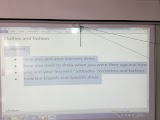We spent most of the morning preparing our projects. In the afternoon, we enjoyed a very interesting talk given by Gillie Cunningham, about the role errors and mistakes play in language learning.
ERRORS ARE OK ARE THEY?
The purpose of this talk is to analyze the attitude we have to correcting learners’ process of learning through error correction and mistakes.
Firs of all we have to look at the difference between an error and a mistake.
An error is when the learner doesn’t know the rule and says something wrong, but through lack of previous knowledge of that rule. Once the learner knows an aspect of the language and says it wrong, we can consider it a mistake.
So what attitude do we take to errors, then?
WE are to hold a mirror to our teaching, and ask ourselves what is right?
We start off with a worksheet with a few sentences produced by native speakers, which are either correct, acceptable with minor mistakes or wrong. WE are asked to go through them and check our result s i pairs. The interesting thing is that native speakers make mistakes without realizing it.
Eg. I already did it.
WMS Cunningham first made an overview of the different methods over the years in the 1950’s and 198’s
The traditional method was to listen and repeat.
To learn though drills, and listening and repeating “Set pieces”
Ms Cunningham gave the example of a role play in which a woman would ask for tissues and the seller would tell her the price. The suggestion is that there is little “real” communication taking place.
Other examples of this type of learning are grammar and vocabulary drills, gap-fills, and a great emphasis on pronunciation.
She then introduced four different theorists who have been very influential through the years.
These were:
Caleb Cattegno (the Silent way)
Charles Curran (CLL)
George Lozanov (Suggestopedia)
James Asher (Total PHysical response)
The Silent way
THe teacher would conduct the lesson without ver speaking. This method consisted in displaying coded sound charts across the classroom and students would have to produce the sound themselves, but students would have to look at the teacher mimicking the sound with the mouth (without actually saying it).
This way, the learner would acquire the sounds himself without having to rely on the teacher as a model. Teaching was subservient to learning. The idea was to avoid “spoon-feeding”.
The second method was Community Language Learning,developed by Charles Curran, who had trained as a counselor.
Here the importance lies in s the sense of community in the learning group, it encourages interaction as a vehicle of learning, and it considers as a priority the students' feelings.This method refers to two roles: that of the know-er (teacher) and student (learner).
The third method was Suggestopedia
The idea is to “de-stress” students, so ideally, students will be sat on armchairs, with classical music playing in the background and with their books. Student would then close their eyes and the teacher reads to them. Error correction is absolutely “banned” as it will stress the students, and the idea is for the students to enjoy themselves. A technique used is to activate fun and games at the beginning of a class after something has been learnt in the previous one. Never tell students that something is difficult. The teachers of this method never corrected students.
The fourth method is Total Physical Response
It is based on “Trace” theory.
The more intense the emotion the language is associated with, the more it will be remembered.
An example would be of a class where students are asked to throw their coats and umbrellas to the floor, stand in a circle, and pretend ethic are going to different places in a city (which would be decorated with posters indicating these places eg. bus station, ticket office), then asked to go to these places: put on your coat, go to the bus station, get on the bus. A lot of vocabulary can be learned through the principle of tracing- emotion commits learning to memory.
First we have to consider how a child learns a language.
A child would say something and the parent would check the content, not the grammar. The grammar would be the second stage.
Eg. I ha
The next part of the session takes us to whether the purpose of language is to achieve communication between the speaker and listener or by the writer and reader. irrespective of the mistakes produced.
A good idea according to Ms Cunningham is to correct vowel sounds silently
The fear os speaking can appear for fear of making a mistake
Attitudes to correction
Self-correction is ideal
Teacher to student correction is acceptable to a certain extent, although not according to certain authors like Penny Ur.
Student to student correction is desirable, even though they don’t like it when they are corrected by peers.
Another idea is to use gestures to indicate different tenses. Eg. Present Perfect - now, past simple, past perfect. etc. You can indicate the different tenses by shifting your position. Very close by indicates present- perfect, a bit further away past simple and so on. Other gestures to mark the continuos and simple aspect
Recap
What is acceptable English? Who decides this?
Do I have a principled and constant approach to error and correction?
Have I tested enjoyed correction techniques
Would I benefit from doing some classroom research on them?
Finally Ms Cunningham ended her talk with two very interesting ideas.
The first was the idea that there is no known "perfect" method that will ensure that a learner of a language will learn, or in other words, the process of acquisition of a language is not scientific, it depends on many different factors.
This made me think about scientists today trying to solve the mystery of how the brain works, as it
still remains unsolved.
And finally, a photo of Einstein and the caption
"Learning is experience, the rest is information"









